之前做毕业设计时,苦于没有高质量的图文数据对,了解到可以由图片生成文本,但也就体验了下模型效果,并没有进行这方面的学习,现在借此机会了解了解。
前言
image caption的目标就是根据提供的图像,输出对应的文字描述。如下图所示:

对于图片描述任务,应该尽可能写实,即不需要华丽的语句,只需要陈述图片所展现的事实即可。根据常识,可以知道该任务一般分为两个部分,一是图片编码,二是文本生成,基于此后续的模型也都是encoder-decoder的结构。
人类可以将图像中的视觉信息自动建立关系,进而感知图像的高层语义信息,但是计算机只能提取图像的特征信息,无法向人类大脑一样生成高层语义信息,这就是“语义鸿沟问题”。图像描述技术可以将视觉信息转化为语义信息,有利于解决“语义鸿沟”。
方法
1 传统image caption方法
1.1 基于模板的方法
生成的句子有固定的模板,检测图像中物体、场景和动作等相关元素,在模板中填充相关的词语,组合成句子
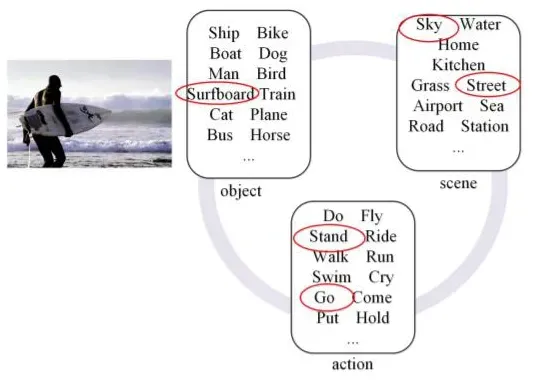
该方法虽然可以生成对图像的准确描述,但是缺点也十分明显,生成的内容单一且较为固定,并且人工参与程度较高。
1.2 基于检索的方法
通过图片匹配的方式实现。先将大量的(图像,图像描述)存入数据库,之后将输入图像与数据库中的图像进行对比,找出相似的图像,将对应的图像描述作为作为候选描述,再对这些描述进行合理的组织,生成输入图像的描述。
这种方法的性能依赖于标注数据集的大小和检索算法,并且受限于相似度计算的准确程度,生成的描述也相对局限,不一定能满足要求。
2 基于深度学习的image caption方法
基于深度学习的方法,概括起来就是有编码器实现对图像的编码,再由解码器生成对应的文字,结合了图像处理和自然语言生成两个方向。
2.1 NIC
论文:Show and Tell: A Neural Image Caption Generator
链接:https://arxiv.org/abs/1411.4555
“show and tell”这篇论文,于2015年提出,首次将深度学习引入image caption任务,提出了encoder-decoder的框架。

作者使用CNN提取图像特征,使用LSTM作为解码器生成对应的图像描述
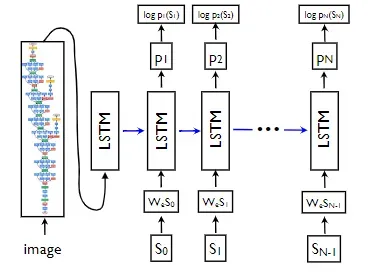
根据上图,有如下计算流程:
式中,表示图像编码,
表示将单词进行向量化的参数矩阵,
表示图像对应的描述句子,其中
表示句子的起始字符,
表示句子的结束字符,也就是说,如果有句子
there are two books and one pen,那么其应该被处理为<start> there are two books and one pen <end>的形式,当解码器生成<end>时,表示句子生成结束。
使用极大似然估计计算损失函数:
2.2 注意力机制
论文:Show, Attend and Tell: Neural Image Caption Generation with Visual Attention
链接:https://arxiv.org/abs/1502.03044
这篇文章于2015年发布,在NIC的基础上引入了注意力机制,主要对解码器的结构进行改变,其示意图如下:

文中,作者一共实验了三种注意力机制,分别为additive attention、stochastic hard attention和deterministic soft attention。
2.2.1 additive attention
注意力权重的计算方式为:
式中,表示注意力权重;
表示时间步;
表示图像的区域
;
表示图像区域
的向量表示;
为LSTM上一个时间步的隐藏层的输出;
是注意力模型,由多层MLP实现;
表示上下文向量;
为一个功能函数,返回单个向量
这里需要注意力得是,前面式子中,注意力模型以多层MLP实现,这是一种叫做“additive attention”的注意力机制。这种方法可以直接看作加权平均,在形式上,给定两组向量:输入向量和隐向量
,则
和
之间的附加注意力计算方式为:
式中,表示激活函数,其代码实现如下:
class Attention(nn.Module):
"""
Attention Network.
"""
def __init__(self, encoder_dim, decoder_dim, attention_dim):
"""
:param encoder_dim: feature size of encoded images
:param decoder_dim: size of decoder's RNN
:param attention_dim: size of the attention network
"""
super(Attention, self).__init__()
self.encoder_att = nn.Linear(encoder_dim, attention_dim) # linear layer to transform encoded image
self.decoder_att = nn.Linear(decoder_dim, attention_dim) # linear layer to transform decoder's output
self.full_att = nn.Linear(attention_dim, 1) # linear layer to calculate values to be softmax-ed
self.relu = nn.ReLU()
self.softmax = nn.Softmax(dim=1) # softmax layer to calculate weights
def forward(self, encoder_out, decoder_hidden):
"""
Forward propagation.
:param encoder_out: encoded images, a tensor of dimension (batch_size, num_pixels, encoder_dim)
:param decoder_hidden: previous decoder output, a tensor of dimension (batch_size, decoder_dim)
:return: attention weighted encoding, weights
"""
att1 = self.encoder_att(encoder_out) # (batch_size, num_pixels, attention_dim)
att2 = self.decoder_att(decoder_hidden) # (batch_size, attention_dim)
att = self.full_att(self.relu(att1 + att2.unsqueeze(1))).squeeze(2) # (batch_size, num_pixels)
alpha = self.softmax(att) # (batch_size, num_pixels)
attention_weighted_encoding = (encoder_out * alpha.unsqueeze(2)).sum(dim=1) # (batch_size, encoder_dim)
return attention_weighted_encoding, alpha
2.2.2 stochastic hard attention
对于随机注意力机制有:
式中,表示在生成第
个单词时,模型会集中注意力的位置变量;
表示一种one-hot形式,当区域
用于提取视觉特征时置1,否则置0。
模型的目标函数为:
在此注意力机制下,的功能就是,基于由
参数化的分布(伯努利)中,在每个时间点采样一个
2.2.3 deterministic soft attention
hard attention需要在每个时间步采样,而soft attention直接使用上下文向量
的期望:
接着通过对注释向量加权来确定注意力模型:
这样得到的模型是平滑可微的。
下图为使用soft attention和hard attention的效果对比图:

2.3 其他深度学习网络
2.3.1 review networks
论文:Review Networks for Caption Generation
链接:https://arxiv.org/abs/1605.07912
源码:https://github.com/kimiyoung/review_net
模型结构如下所示:
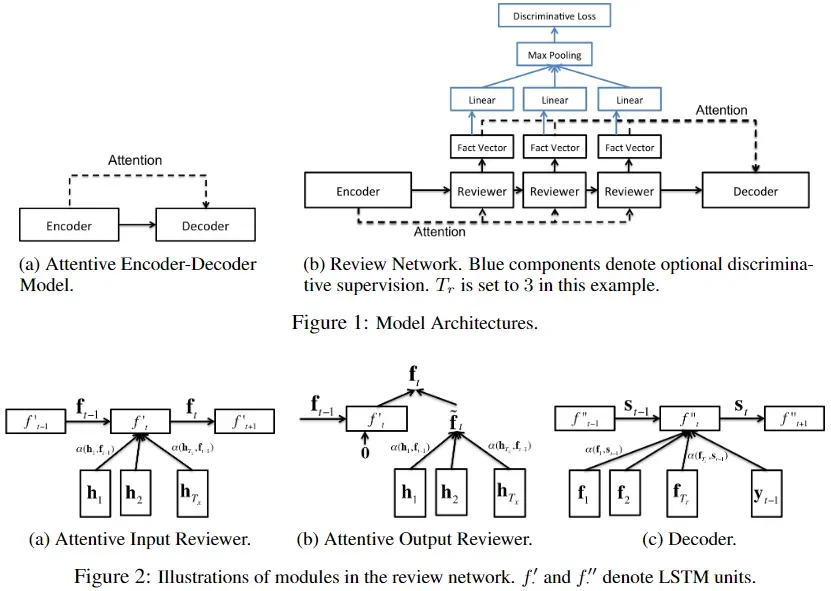
模型的编码器使用的是VGG,解码器使用的是LSTM,比较特别的是,该模型定义了review结构,该结构利用注意力网络对解码器的输入与输出进行了改变。
review包括attentive input reviewer和attentive output reviewer
(1)attentive input reviewer
在每个时间步,使用注意力对隐藏层进行处理,接着用注意力的结果作为解码器中LSTM的输入。有如下公式:
式中,表示注意力输出;
表示第
个隐层的权重。
可以用点积计算,也可以使用多层MLP;
表示LSTM单元。
(2)attentive output reviewer
有如下计算公式:
可以看到,与attentive input reviewer的输入不同
(3)Discriminative Supervision
在传统的编码器-解码器模型中,模型的目标是最大化生成序列的条件概率,然而,作者使用了判别性的监督方法,对目标进行预测,如上图蓝色部分所示。简单来说,作者添加了一个损失函数,这个函数有别于生成式模型的损失函数,(或者说,这个损失函数属于判别式模型)。该函数的计算公式如下:
式中,表示归一化因子,
表示出现在
中所有单词的集合,
表示输出,
表示单词
经过最大池化层后的得分。
模型最后的损失为负的条件对数似然与判别性损失的加权和:
式中,表示输出序列
的长度;
表示reviewer输出的
thought vectors向量集合;表示经过softmax层后的单词
的概率;
表示第
个解码的字符;
表示
的word embedding。
2.3.2 SCA-CNN
论文:SCA-CNN: Spatial and Channel-wise Attention in Convolutional Networks for Image Captioning
链接:https://arxiv.org/abs/1611.05594
源码:https://github.com/zjuchenlong/sca-cnn.cvpr17
作者认为已有的研究通常使用的是空间注意力(注意力被建模为空间概率,也就是重新加权CNN编码器的最后一个卷积层),这种注意力并不是真正的注意力机制,因此,在CNN中结合了空间和通道注意力。简单来说,作者认为之前使用的注意力不够全面,所以自己在多个不同的地方使用了注意力。
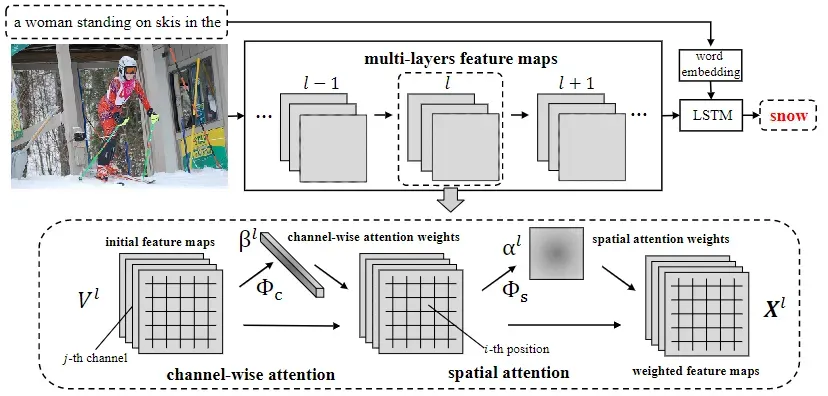
模型的计算流程如下:
式中,表示第
层网络层;
表示注意力权重;
表示注意力函数;
表示线性加权函数;
表示卷积层的总数。其中注意力权重
由空间注意力
和通道级注意力
组成:
这篇文章的核心为spatial attention和channel wise attention。
(1)spatial attention
空间注意力,也是已有的模型使用的注意力。在已有模型中,仅对编码器最后一个卷积层的feature map使用该注意力机制。在SCA-CNN中,利用了多层卷积提取特征不同的特点,在多层上使用该注意力机制。作者认为,最后一层卷积层的输出已经是后期的输出,也就是说特征基本已经提取完毕,各个像素点之间的差异变小了,注意力机制的效果可能无法有效发挥,而前面网络层的输出,各像素点之间的差异较大,可以更好的发挥注意力机制的效果。
其计算方式为:
式中,表示矩阵与向量相加。
(2)channel wise attention
与空间注意力不同,通道级注意力作用于feature map之间,给每个channel进行加权,所以权重值为向量。作者在编码器网络中,嵌入了这两种注意力机制,并且在多个网络层上进行该操作。
其计算方式为:
式中,表示向量的外积
(3)两种注意力机制的结合方式
作者给出了两种结合方式,channel-spatial和spatial-channel
channel-spatial
通道级注意力在前,空间注意力在后:
spatial-channel
空间注意力在前,通道级注意力在后:
2.3.3 Graph encoder
(1)spatial and semantic graphs
论文:Exploring Visual Relationship for Image Captioning
链接:https://arxiv.org/abs/1809.07041
论文提出了GCN-LSTM模型,使用图卷积网络GCN整合目标之间的语义和空间关系,并将之用于图片编码。

首先使用Faster R-CNN对图像的显著区域进行提取,并构建区域语义有向图(语义图的顶点代表每个区域,边表示每对区域之间的关系)和空间有向图(空间图的顶点表述区域,边表示区域之间的位置关系),以GCN获取embedding输出,再通过带有注意力机制的双层LSTM生成对应的描述。
编码器
原始的GCN使用的是无向图,其计算方式为:
式中,表示激活函数,
表示
的邻居节点(包括它自己)。
为了使GCN可以融合有向图,并能处理图的标签信息,作者对上式进行了修改:
式中,表示根据每条边的方向选择变换矩阵,如
表示
,
表示
,
表示
。
表示每条边的标签。并且,作者给图的每条边加上了门控:
式中,就表示门控。
解码器
解码器使用的注意力机制+双层LSTM的结构。其中,第一层LSTM的参数更新方式为:
式中,表示第二层LSTM的上一个时间步的输出,
表示输入单词,
表示输入单词对应的转换矩阵,
表示经过平均池化后的图像特征。接着根据输出
计算注意力权重:
根据注意力得分对图像特征进行加权:
接着合并和
,将其作为第二层LSTM的输入:
最后,以作为
层的输入,预测下一个单词。
(2)hierarchical trees
论文:Hierarchy Parsing for Image Captioning
链接:https://arxiv.org/abs/1909.03918
该文主要是对编码器进行改进。将图像表示为树形的层次结构,以整体图像作为根节点,中层表示图像的区域,叶节点表示图像区域中的实例对象,接着,将图像树送入TreeLSTM获取图像编码,以提取图像的多层次特征。
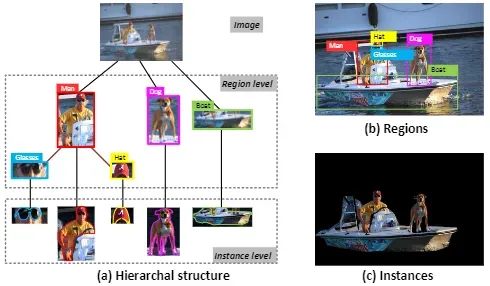
接着,根据图像的层次结构,构建有向图,图的顶点为每个区域或者实例,边表示每对区域或实例之间的关系。

上图为作者提出的层次解析架构(HIP),使用Faster R-CNN检测目标区域,使用Mask R-CNN分割实例集,接着搭建三层的层次树结构,并使用Tree-LSTM自下而上执行,以增强区域和实例特征,并以LSTM实现文本的生成。图的右半部分为作者将HIP结构接入GCN-LSTM模型的示意图。
Tree-LSTM
Tree-LSTM的主要作用就是提取图像的层级特征,其结构如下:
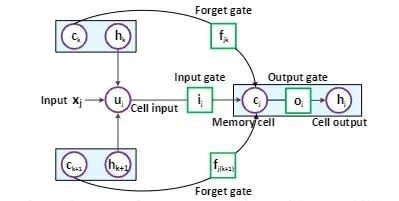
与原始的LSTM不同,Tree-LSTM的状态更新依赖子节点的多个隐藏状态。其状态更新公式如下:
式中,表示当前节点的子集;
表示两个向量点积。Tree-LSTM的输入为:
式中,表示区域特征编码,
表示实例特征编码
2.3.4 self-attention encoder
(1)Self-Attention
论文:Learning to Collocate Neural Modules for Image Captioning
链接:https://arxiv.org/abs/1904.08608
这篇文章的核心就是使用多个网络模块并行(CNM,Collocate Neural Modules)的方式,增强编码器的特征提取能力。不过,值得注意的是,在其中一个模块中,作者使用了多头自注意力。
模型的简要结构如下:
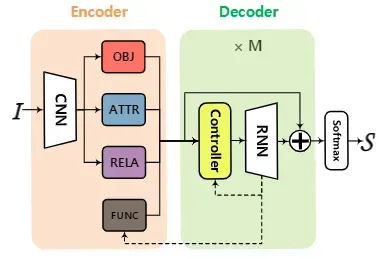
编码器
图中的四个模块分别为object module、attribute module、relation module和function module。
- object module专注于对象类别
- attribute module侧重于视觉属性
- relation module使用了多头自注意力网络,用以学习两个对象之间的交互。其输入为Faster R-CNN提取的ROI特征
- function module用来生成一个功能词,如“a”和“and”
可以结合下图对上述四个模块进行理解:
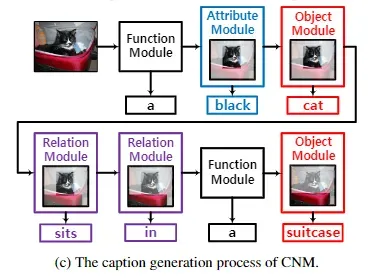
解码器
解码器使用的了Controller,其结构如下:
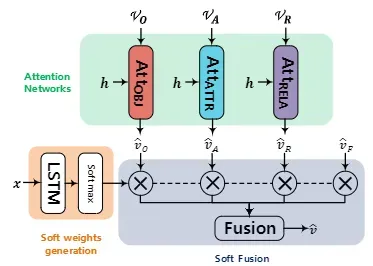
可以看到,该结构包括三个注意力网络和一个LSTM,Controller的输出将会作为后接LSTM的输入,用以生成下一个单词。
其计算流程如下:
1)引入加性注意力机制,将三个视觉模块的输出进行加权
object att:
attribute att:
relation att:
式中表示当前时间步,第一个LSTM的输出。
2)计算soft weight
式中表示第二个LSTM在
时刻的输出。
上述文章仅在视觉特征提取方面用了soft-attention的结构,并且该部分特征也只是特征工程的一部分。下面介绍一篇在解码器中使用soft-attention的文章,更确切地说,其使用Transformer的解码器代替了原有的RNN结构的解码器。
论文:Learning to Collocate Neural Modules for Image Captioning
链接:https://arxiv.org/abs/1904.08608
这篇文章的核心就是将原有的RNN结构的解码器用Transformer的解码器替代了,并定义了多级监督机制用以更好的生成当前单词。模型结构如下:
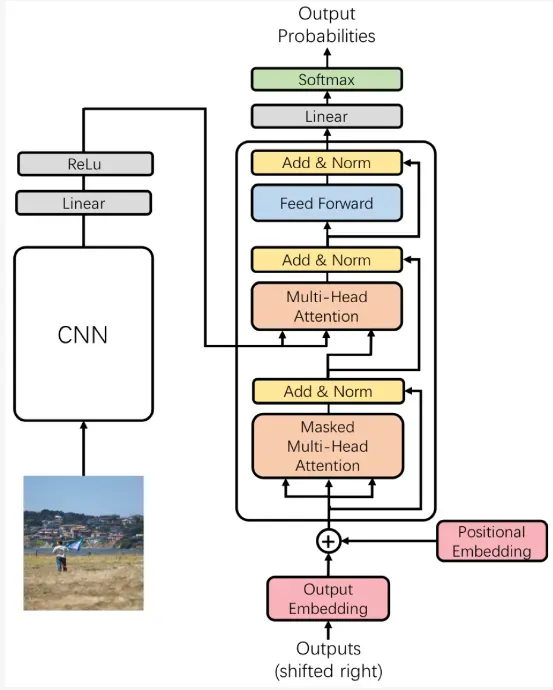
多级监督机制结构如下:

在推理阶段,使用平均池化组合每层的输出,获取单词概率。在训练阶段,使用多输出交叉熵损失:
式中,表示真实句子,
表示图像,
表示模型参数。
(2)Attention on Attention
论文:Attention on Attention for Image Captioning
链接:https://arxiv.org/abs/1908.06954
源码:https://github.com/husthuaan/AoANet
这篇文章主要是对注意力机制的改进,作者提出了“attention on attention”的方法,该方法通过计算注意力的结果与输入query的相关性来对信息进行过滤,作者最后将该方法运用在编码器和解码器中。
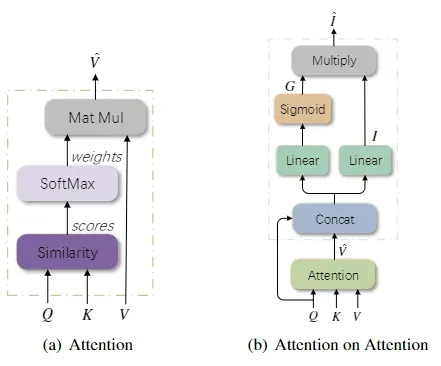
可以看到,AOA中表示“information vector”,
表示“attention gate”,最后通过逐元素乘法添加另一个注意力。
将“attention gate”应用于“information vector”:
式中,表示逐元素相乘。作者将这认为是一种注意力,感觉应该是种加性注意力吧。最后,AOA的计算方式如下:
作者在实现AOA的时候也是相对比较简单:
#定义
if self.use_aoa:
self.aoa_layer = nn.Sequential(nn.Linear((1 + scale) * d_model, 2 * d_model), nn.GLU())
# dropout to the input of AoA layer
if dropout_aoa > 0:
self.dropout_aoa = nn.Dropout(p=dropout_aoa)
else:
self.dropout_aoa = lambda x:x
if self.use_aoa:
# Apply AoA
x = self.aoa_layer(self.dropout_aoa(torch.cat([x, query], -1)))
编码器
编码器结构如下:
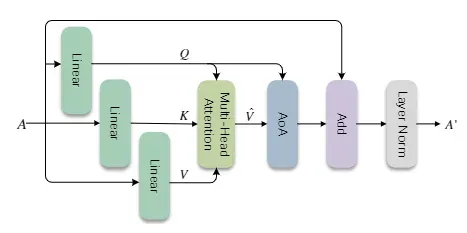
图中和
的计算方式如下:
式中,就是多头自注意力机制的计算方式,这里就不再进行赘述;
表示CNN输出的图像特征。
可以看到,相比于原始Transformer结构,该编码器增加了AOA结构,并且去掉了前馈网络层,之所以去掉该层作者给出了两个原因:
- 原始结构的前馈网络层是为了增加非线性信息,而本文提出的结构AOA已经满足了这个要求
- 删除前馈网络层并不会影响模型的效果,而且简化了模型的结构
代码实现为:
class AoA_Refiner_Layer(nn.Module):
def __init__(self, size, self_attn, feed_forward, dropout):
super(AoA_Refiner_Layer, self).__init__()
self.self_attn = self_attn
self.feed_forward = feed_forward
self.use_ff = 0
if self.feed_forward is not None:
self.use_ff = 1
self.sublayer = clones(SublayerConnection(size, dropout), 1+self.use_ff)
self.size = size
def forward(self, x, mask):
x = self.sublayer[0](x, lambda x: self.self_attn(x, x, x, mask))
return self.sublayer[-1](x, self.feed_forward) if self.use_ff else x
class AoA_Refiner_Core(nn.Module):
def __init__(self, opt):
super(AoA_Refiner_Core, self).__init__()
attn = MultiHeadedDotAttention(opt.num_heads, opt.rnn_size, project_k_v=1, scale=opt.multi_head_scale, do_aoa=opt.refine_aoa, norm_q=0, dropout_aoa=getattr(opt, 'dropout_aoa', 0.3))
layer = AoA_Refiner_Layer(opt.rnn_size, attn, PositionwiseFeedForward(opt.rnn_size, 2048, 0.1) if opt.use_ff else None, 0.1)
self.layers = clones(layer, 6)
self.norm = LayerNorm(layer.size)
def forward(self, x, mask):
for layer in self.layers:
x = layer(x, mask)
return self.norm(x)
解码器
解码器的结构如下:
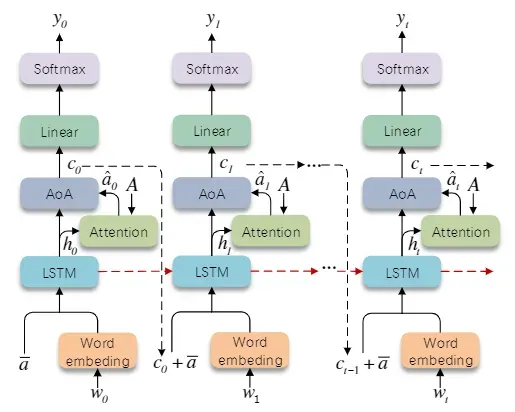
作者对上下文向量建模,计算词语的条件概率:
保存着解码状态和新获取的信息,由编码器输出的
和LSTM输出的
生成。LSTM的输入为输入单词的向量表征、上下文向量和编码暗器的输出:
式中,在时间步
下,输入单词的One-hot编码。
代码实现如下:
class AoA_Decoder_Core(nn.Module):
def __init__(self, opt):
super(AoA_Decoder_Core, self).__init__()
self.drop_prob_lm = opt.drop_prob_lm
self.d_model = opt.rnn_size
self.use_multi_head = opt.use_multi_head
self.multi_head_scale = opt.multi_head_scale
self.use_ctx_drop = getattr(opt, 'ctx_drop', 0)
self.out_res = getattr(opt, 'out_res', 0)
self.decoder_type = getattr(opt, 'decoder_type', 'AoA')
self.att_lstm = nn.LSTMCell(opt.input_encoding_size + opt.rnn_size, opt.rnn_size) # we, fc, h^2_t-1
self.out_drop = nn.Dropout(self.drop_prob_lm)
if self.decoder_type == 'AoA':
# AoA layer
self.att2ctx = nn.Sequential(nn.Linear(self.d_model * opt.multi_head_scale + opt.rnn_size, 2 * opt.rnn_size), nn.GLU())
elif self.decoder_type == 'LSTM':
# LSTM layer
self.att2ctx = nn.LSTMCell(self.d_model * opt.multi_head_scale + opt.rnn_size, opt.rnn_size)
else:
# Base linear layer
self.att2ctx = nn.Sequential(nn.Linear(self.d_model * opt.multi_head_scale + opt.rnn_size, opt.rnn_size), nn.ReLU())
# if opt.use_multi_head == 1: # TODO, not implemented for now
# self.attention = MultiHeadedAddAttention(opt.num_heads, opt.d_model, scale=opt.multi_head_scale)
if opt.use_multi_head == 2:
self.attention = MultiHeadedDotAttention(opt.num_heads, opt.rnn_size, project_k_v=0, scale=opt.multi_head_scale, use_output_layer=0, do_aoa=0, norm_q=1)
else:
self.attention = Attention(opt)
if self.use_ctx_drop:
self.ctx_drop = nn.Dropout(self.drop_prob_lm)
else:
self.ctx_drop = lambda x :x
def forward(self, xt, mean_feats, att_feats, p_att_feats, state, att_masks=None):
# state[0][1] is the context vector at the last step
h_att, c_att = self.att_lstm(torch.cat([xt, mean_feats + self.ctx_drop(state[0][1])], 1), (state[0][0], state[1][0]))
if self.use_multi_head == 2:
att = self.attention(h_att, p_att_feats.narrow(2, 0, self.multi_head_scale * self.d_model), p_att_feats.narrow(2, self.multi_head_scale * self.d_model, self.multi_head_scale * self.d_model), att_masks)
else:
att = self.attention(h_att, att_feats, p_att_feats, att_masks)
ctx_input = torch.cat([att, h_att], 1)
if self.decoder_type == 'LSTM':
output, c_logic = self.att2ctx(ctx_input, (state[0][1], state[1][1]))
state = (torch.stack((h_att, output)), torch.stack((c_att, c_logic)))
else:
output = self.att2ctx(ctx_input)
# save the context vector to state[0][1]
state = (torch.stack((h_att, output)), torch.stack((c_att, state[1][1])))
if self.out_res:
# add residual connection
output = output + h_att
output = self.out_drop(output)
return output, state
(3)Geometry-Aware Self-Attention
论文:Captioning Transformer with Stacked Attention Modules
链接:https://www.mdpi.com/2076-3417/8/5/739
在这篇文章中,作者提出了“归一化的自注意力(NSA)”和“Geometry-aware self-attention(GSA)”。简单来说,作者有两个创新点,一是自定义了一种归一化的方法用以代替layer normalization(LN),并提出了一种适用于图像的位置信息表示方法,将该方法用于自注意力机制中。
self-attention network(SAN)
注意力网络用于图像描述的一般范式如下:
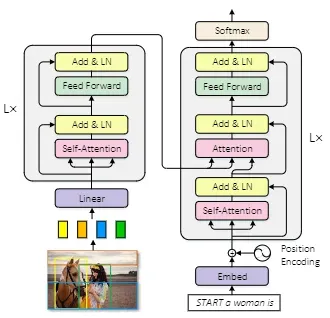
一般模型会遵循Transformer的结构,使用编码器对图像编码,使用解码器生成文本。作者的模型整体结构与SAN相似,不过其在归一化和位置信息上做了改变。
NSA
原始的soft-attention的计算方式为:
作者给出的计算方式为:
可以看到,作者以一个全连接层代替了原有的矩阵乘积的方式。
GSA
针对图像区域的特点,引入区域的位置信息,其表示方式如下:
式中,表示图像区域中心坐标;
表示区域的宽;
表示区域的高。
接着使用全连接层将映射到高维向量表征:
将的信息加入到注意力得分中:
式中,表示几何注意力函数;
是几何注意力机制的查询和键,其计算方式与自注意力一致。对于
有三种选择:
- Content-independent:
- Query-dependent:
- Key-dependent:
作者在实验时,NSA并未用于解码器中,因为解码器是自回归模型,其长度可变的性质不适合。
3 基于预训练模型的image caption方法
3.1 VLP
论文:Unified Vision-Language Pre-Training for Image Captioning and VQA
链接:https://arxiv.org/abs/1909.11059
源码:https://github.com/LuoweiZhou/VLP
该文章提出的模型既可以完成生成式任务,又可以完成理解式任务,并且使用共享的多层Transformer层进行编码和解码。VLP在大量的图文对上进行预训练,训练任务为“image caption”和“visual question answer”。模型的训练方式如下图所示:
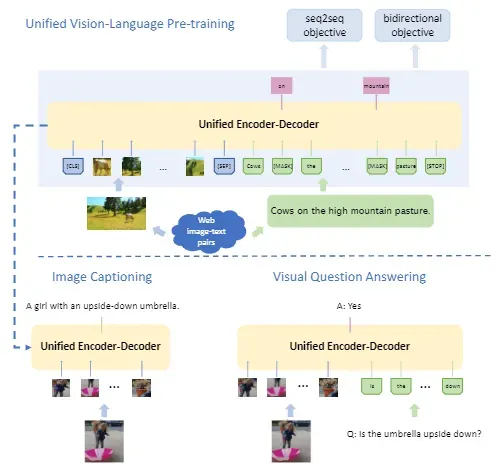
可以看到,在预训练阶段,图像信息在文本信息的前面。
模型的结构如下图所示:
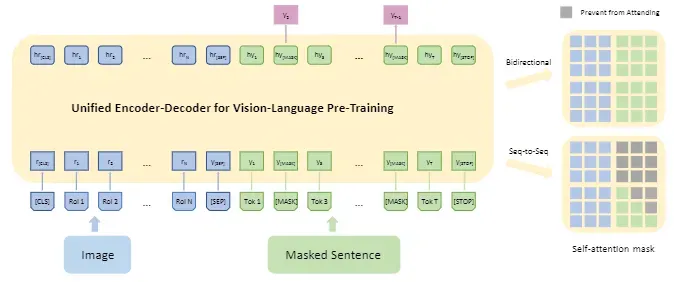
可以看到模型的输入为:region embedding、word embedding和三个特殊toekn。
图文embedding编码合并的代码实现:
if vis_input:
words_embeddings = torch.cat((words_embeddings[:, :1], vis_feats,
words_embeddings[:, len_vis_input+1:]), dim=1)
assert len_vis_input == 100, 'only support region attn!'
position_embeddings = torch.cat((position_embeddings[:, :1], vis_pe,
position_embeddings[:, len_vis_input+1:]), dim=1) # hacky...
模型的结构与BERT一致,都是12层的Transformer层,不同之处就是输入和训练任务了。
3.2 BLIP
论文:BLIP: Bootstrapping Language-Image Pre-training for Unified Vision-Language Understanding and Generation
链接:https://arxiv.org/abs/2201.12086
源码:https://github.com/salesforce/BLIP
作者分析了已有的模型在模型结构和数据来源的不足,做出了两个贡献。1)提出了一种编码器-解码器的多模式混合结构,可以有效的进行多任务的预训练和迁移学习;2)提出了一种bootstrapping方法,用以处理数据集,这是一种数据增强的方法。BLIP在零样本或小样本学习上表现十分不错。
(1)模型方面
BLIP模型结构如下:
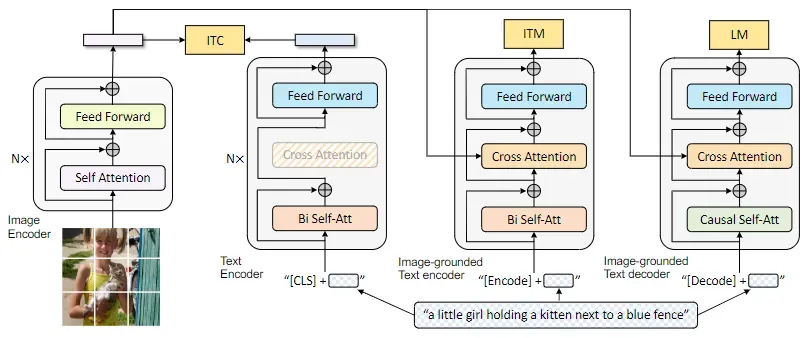
图中,相同颜色模块具有相同的参数。可以看到,模型可以分为三个板块,其中ITC表示“image-text contrative”,用来对齐视觉和语言表示;ITM表示“image-text matching”,使用交叉注意力层来模拟图文信息交互,来区分正负图像-文本对;LM表示“language model”,用causal注意力代替双向注意力机制,并且与编码器共享参数,用来生成图片描述。作者将这种结构称作MED(multimodal mixture of encoder-decoder)。
模型可以运行符合unimodal encoder、image-grounded text encoder和image-grounded text decoder三种形式的任务。
unimodal encoder
图像和文本编码,文本编码器与BERT一致,字符“[CLS]”用作文本编码表示。
代码实现如下:
image_embeds = self.visual_encoder(image)
image_atts = torch.ones(image_embeds.size()[:-1],dtype=torch.long).to(image.device)
image_feat = F.normalize(self.vision_proj(image_embeds[:,0,:]),dim=-1)
text = self.tokenizer(caption, padding='max_length', truncation=True, max_length=30,
return_tensors="pt").to(image.device)
text_output = self.text_encoder(text.input_ids, attention_mask = text.attention_mask,
return_dict = True, mode = 'text')
text_feat = F.normalize(self.text_proj(text_output.last_hidden_state[:,0,:]),dim=-1)
# get momentum features
with torch.no_grad():
self._momentum_update()
image_embeds_m = self.visual_encoder_m(image)
image_feat_m = F.normalize(self.vision_proj_m(image_embeds_m[:,0,:]),dim=-1)
image_feat_all = torch.cat([image_feat_m.t(),self.image_queue.clone().detach()],dim=1)
text_output_m = self.text_encoder_m(text.input_ids, attention_mask = text.attention_mask,
return_dict = True, mode = 'text')
text_feat_m = F.normalize(self.text_proj_m(text_output_m.last_hidden_state[:,0,:]),dim=-1)
text_feat_all = torch.cat([text_feat_m.t(),self.text_queue.clone().detach()],dim=1)
sim_i2t_m = image_feat_m @ text_feat_all / self.temp
sim_t2i_m = text_feat_m @ image_feat_all / self.temp
sim_targets = torch.zeros(sim_i2t_m.size()).to(image.device)
sim_targets.fill_diagonal_(1)
sim_i2t_targets = alpha * F.softmax(sim_i2t_m, dim=1) + (1 - alpha) * sim_targets
sim_t2i_targets = alpha * F.softmax(sim_t2i_m, dim=1) + (1 - alpha) * sim_targets
sim_i2t = image_feat @ text_feat_all / self.temp
sim_t2i = text_feat @ image_feat_all / self.temp
loss_i2t = -torch.sum(F.log_softmax(sim_i2t, dim=1)*sim_i2t_targets,dim=1).mean()
loss_t2i = -torch.sum(F.log_softmax(sim_t2i, dim=1)*sim_t2i_targets,dim=1).mean()
loss_ita = (loss_i2t+loss_t2i)/2
image-grounded text encoder
在双向自注意力和前馈网络层之间插入了交叉注意力,用作图文特征的交互。并定义了特殊字符“[Encode]”,放置在文本开头,用作多模态表示。
代码实现如下:
encoder_input_ids = text.input_ids.clone()
encoder_input_ids[:,0] = self.tokenizer.enc_token_id
# forward the positve image-text pair
bs = image.size(0)
output_pos = self.text_encoder(encoder_input_ids,
attention_mask = text.attention_mask,
encoder_hidden_states = image_embeds,
encoder_attention_mask = image_atts,
return_dict = True,
)
with torch.no_grad():
weights_t2i = F.softmax(sim_t2i[:,:bs],dim=1)+1e-4
weights_t2i.fill_diagonal_(0)
weights_i2t = F.softmax(sim_i2t[:,:bs],dim=1)+1e-4
weights_i2t.fill_diagonal_(0)
# select a negative image for each text
image_embeds_neg = []
for b in range(bs):
neg_idx = torch.multinomial(weights_t2i[b], 1).item()
image_embeds_neg.append(image_embeds[neg_idx])
image_embeds_neg = torch.stack(image_embeds_neg,dim=0)
# select a negative text for each image
text_ids_neg = []
text_atts_neg = []
for b in range(bs):
neg_idx = torch.multinomial(weights_i2t[b], 1).item()
text_ids_neg.append(encoder_input_ids[neg_idx])
text_atts_neg.append(text.attention_mask[neg_idx])
text_ids_neg = torch.stack(text_ids_neg,dim=0)
text_atts_neg = torch.stack(text_atts_neg,dim=0)
text_ids_all = torch.cat([encoder_input_ids, text_ids_neg],dim=0)
text_atts_all = torch.cat([text.attention_mask, text_atts_neg],dim=0)
image_embeds_all = torch.cat([image_embeds_neg,image_embeds],dim=0)
image_atts_all = torch.cat([image_atts,image_atts],dim=0)
output_neg = self.text_encoder(text_ids_all,
attention_mask = text_atts_all,
encoder_hidden_states = image_embeds_all,
encoder_attention_mask = image_atts_all,
return_dict = True,
)
vl_embeddings = torch.cat([output_pos.last_hidden_state[:,0,:], output_neg.last_hidden_state[:,0,:]],dim=0)
vl_output = self.itm_head(vl_embeddings)
itm_labels = torch.cat([torch.ones(bs,dtype=torch.long),torch.zeros(2*bs,dtype=torch.long)],
dim=0).to(image.device)
loss_itm = F.cross_entropy(vl_output, itm_labels)
image-grounded text decoder
用因果自注意力层替换双向自注意力层,增加了特殊字符“[Decode]”,用于表示序列的开始,序列结束标记依旧用“end”表示。
代码实现如下:
decoder_input_ids = text.input_ids.clone()
decoder_input_ids[:,0] = self.tokenizer.bos_token_id
decoder_targets = decoder_input_ids.masked_fill(decoder_input_ids == self.tokenizer.pad_token_id, -100)
decoder_output = self.text_decoder(decoder_input_ids,
attention_mask = text.attention_mask,
encoder_hidden_states = image_embeds,
encoder_attention_mask = image_atts,
labels = decoder_targets,
return_dict = True,
)
loss_lm = decoder_output.loss
最后,作者结合上述三个模块实现整体的MED结构。
其交叉注意力和因果注意力的实现代码为:
if is_cross_attention:
key_layer = self.transpose_for_scores(self.key(encoder_hidden_states))
value_layer = self.transpose_for_scores(self.value(encoder_hidden_states))
attention_mask = encoder_attention_mask
elif past_key_value is not None:
key_layer = self.transpose_for_scores(self.key(hidden_states))
value_layer = self.transpose_for_scores(self.value(hidden_states))
key_layer = torch.cat([past_key_value[0], key_layer], dim=2)
value_layer = torch.cat([past_key_value[1], value_layer], dim=2)
else:
key_layer = self.transpose_for_scores(self.key(hidden_states))
value_layer = self.transpose_for_scores(self.value(hidden_states))
其中,past_key_value部分就是因果注意力的实现,单说注意力部分,作者通过对key和value的不同定义,来实现交叉注意力和因果注意力。在交叉注意力中,key和value使用来自编码器的输出,在其他注意力中使用来自文本的hidden states。
编码器部分,图片使用的是VIT模型,文本使用的是BERT:
self.visual_encoder, vision_width = create_vit(vit,image_size, vit_grad_ckpt, vit_ckpt_layer)
self.text_encoder = BertModel(config=med_config, add_pooling_layer=False)
(2)数据方面
数据的处理流程如下图所示:
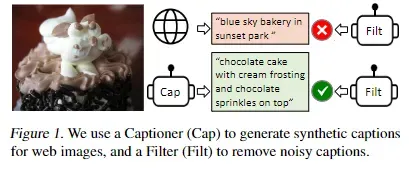
针对网络上的劣质文本数据,作者使用模型生成图片对应的文本描述,并使用过滤器过滤噪声数据,合并两者的结果,形成高质量的图片-文本数据对。
BLIP模型预训练和数据增强的原理如下:
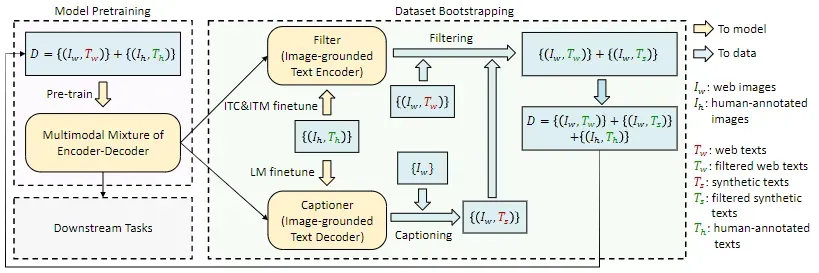
数据处理部分主要有两个模块,captioning(用于生成给定图像的文字描述)和filtering(用于去除噪声图像文本对),两者均以MED进行初始化,并在数据集COCO上微调。最后合并两者的数据集,以新的数据集预训练一个新的模型。
3.3 OFA
论文:OFA: Unifying Architectures, Tasks, and Modalities Through a Simple Sequence-to-Sequence Learning Frameworkon
链接:https://arxiv.org/abs/2202.03052
源码:https://github.com/OFA-Sys/OFA
OFA是阿里巴巴提出的模型,寓意“one for all”,模型统一了多种视觉和语言,理解和生成任务。其预训练任务如下图所示:
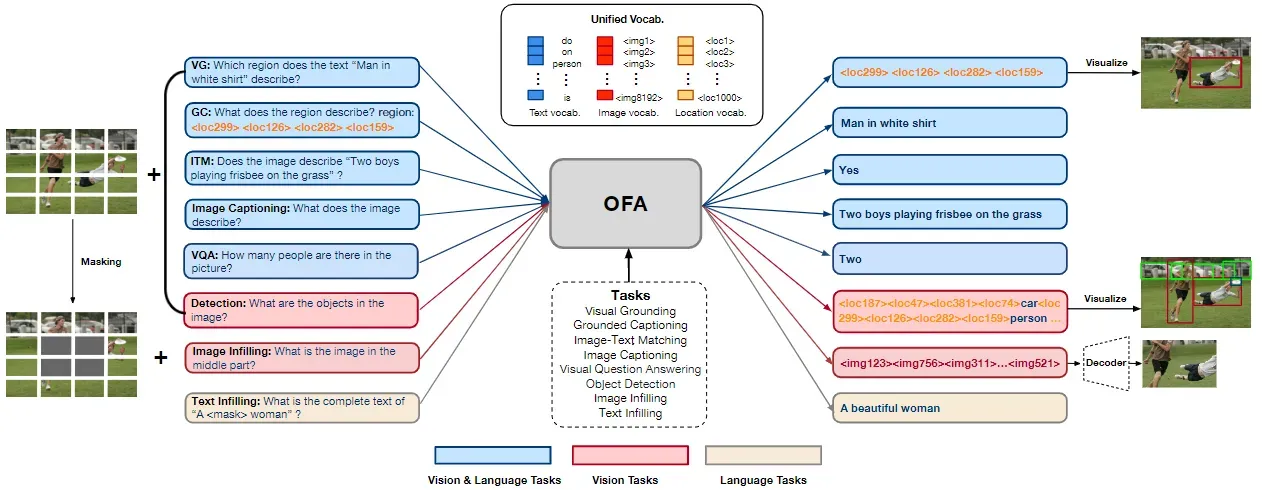
大致包括区域检测、区域字幕、图文匹配、图像字幕、视觉问答、目标检测、图像填充和文本填充。(部分任务名称描述可能不够专业,因为没做过多了解)
模型使用encoder-decoder的架构,并依旧以Transformer为基础实现。由于论文大部分内容展示的是实验,所以可展开的内容较少。
实验
终于到了令人激动的实验环节。本文实验不对模型进行微调,仅展示模型BLIP和OFA的使用方法。
1 BLIP
代码如下:
import requests
from PIL import Image
from transformers import BlipProcessor, BlipForConditionalGeneration
processor = BlipProcessor.from_pretrained("Salesforce/blip-image-captioning-base")
model = BlipForConditionalGeneration.from_pretrained("Salesforce/blip-image-captioning-base").to("cuda")
# img_url = 'https://storage.googleapis.com/sfr-vision-language-research/BLIP/demo.jpg'
img_url = 'https://ww4.sinaimg.cn/thumb150/006ymYXKgy1gahftdd597j31o00u079k.jpg'
raw_image = Image.open(requests.get(img_url, stream=True).raw).convert('RGB')
# conditional image captioning
text = "a photography of"
inputs = processor(raw_image, text, return_tensors="pt").to("cuda")
out = model.generate(**inputs)
print(processor.decode(out[0], skip_special_tokens=True))
# unconditional image captioning
# inputs = processor(raw_image, return_tensors="pt").to("cuda")
# out = model.generate(**inputs)
# print(processor.decode(out[0], skip_special_tokens=True))
零样本下的结果:
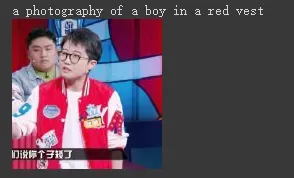
2 OFA
代码如下:
!git clone --single-branch --branch feature/add_transformers https://github.com/OFA-Sys/OFA.git
!pip install OFA/transformers/
!git clone https://huggingface.co/OFA-Sys/OFA-tiny
from PIL import Image
from torchvision import transforms
from transformers import OFATokenizer, OFAModel
from transformers.models.ofa.generate import sequence_generator
import requests
import torch
mean, std = [0.5, 0.5, 0.5], [0.5, 0.5, 0.5]
resolution = 480
patch_resize_transform = transforms.Compose([
lambda image: image.convert("RGB"),
transforms.Resize((resolution, resolution), interpolation=Image.BICUBIC),
transforms.ToTensor(),
transforms.Normalize(mean=mean, std=std)
])
ckpt_dir="OFA-Sys/ofa-large-caption"
tokenizer = OFATokenizer.from_pretrained(ckpt_dir)
txt = " what does the image describe?"
inputs = tokenizer([txt], return_tensors="pt").input_ids
url='https://ww4.sinaimg.cn/thumb150/006ymYXKgy1gahftdd597j31o00u079k.jpg'
img=Image.open(requests.get(url,stream=True).raw)
print(img)
patch_img = patch_resize_transform(img).unsqueeze(0)
# using the generator of fairseq version
model = OFAModel.from_pretrained(ckpt_dir, use_cache=True)
generator = sequence_generator.SequenceGenerator(
tokenizer=tokenizer,
beam_size=5,
max_len_b=16,
min_len=0,
no_repeat_ngram_size=3,
)
data = {}
data["net_input"] = {"input_ids": inputs, 'patch_images': patch_img, 'patch_masks':torch.tensor([True])}
gen_output = generator.generate([model], data)
gen = [gen_output[i][0]["tokens"] for i in range(len(gen_output))]
# using the generator of huggingface version
model = OFAModel.from_pretrained(ckpt_dir, use_cache=False)
gen = model.generate(inputs, patch_images=patch_img, num_beams=5, no_repeat_ngram_size=3)
print(tokenizer.batch_decode(gen, skip_special_tokens=True))
零样本下的结果:
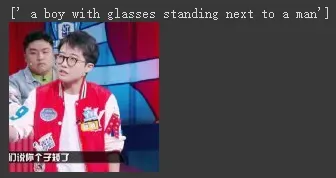
对比两个模型生成的描述:
BLIP: a photography of a boy in a red vest
OFA: a boy with glasses standing next to a man
根据两个模型的结果,我们也不能说谁好谁坏,在我看来,将两者的结果结合可能才是最佳的。
同时,可以发现BLIP和OFA还是有较大差别的,单从这一个例子可以看出,BLIP可以对图像中的视觉信息进行更好的描述(如红色衣服),OFA更注重对图片中的实例信息的描述(如描述了两个人之间的位置关系,描述了戴着眼镜)。换言之,BLIP对视觉特征的提取更好,OFA对实例特征的提取更好。当然,这也与模型的训练数据有关。想进一步了解的同学,可以使用更多的数据集进行对比。
总结
本文围绕image caption,以论文介绍的形式,说明了如何实现image caption。从传统方法、深度学习方法和基于预训练模型的方法,三个方面对已有的研究方法进行了说明。其中传统方法包括:基于模板和基于检索的方法。深度学习方法包括:第一篇论文NIC方法、基于注意力机制的方法、基于图神经的方法、基于自注意力的方法以及其他深度学习方法。基于预训练模型的方法包括:VLP、BLIP和OFA。在介绍完已有方法后,对BLIP和OFA进行了零样本实验。
根据上述方法,可以将其创新点概括为以下几个方面:
-
编码器
- 使用多种网络提取多方面的视觉特征
- 图像层次特征的提取
-
解码器
- 引入注意力机制
- 注意力机制的结构
- 二维位置信息提取
-
预训练模型
- 如何实现多模态交互
本文的不足之处:未对基于对抗网络的方法进行介绍,未对基于强化学习的方法进行介绍,未对代码进行讲解等等。
【参考文章】
1、chrome-extension://bocbaocobfecmglnmeaeppambideimao/pdf/viewer.html?file=http%3A%2F%2Fwww.nlpir.org%2Fwordpress%2Fwp-content%2Fuploads%2F2021%2F10%2FImage_Caption.pdf
2、https://aitechtogether.com/article/12841.html
3、http://html.rhhz.net/tis/html/201910039.htm
4、https://zhuanlan.zhihu.com/p/358127578
5、https://www.yanxishe.com/blogDetail/28479
文章出处登录后可见!
